MULTRYS- trace elements injection 4 injection, solution
Multrys by
Drug Labeling and Warnings
Multrys by is a Prescription medication manufactured, distributed, or labeled by American Regent, Inc.. Drug facts, warnings, and ingredients follow.
Drug Details [pdf]
-
HIGHLIGHTS OF PRESCRIBING INFORMATION
These highlights do not include all the information needed to use MULTRYS® safely and effectively. See full prescribing information for MULTRYS® .
MULTRYS® (trace elements injection 4*) for intravenous use
Initial U.S. Approval: 2020
INDICATIONS AND USAGE
Multrys is a combination of trace elements (zinc sulfate, cupric sulfate, manganese sulfate, and selenious acid) indicated in neonatal and pediatric patients weighing less than 10 kg as a source of zinc, copper, manganese, and selenium for parenteral nutrition when oral or enteral nutrition is not possible, insufficient, or contraindicated. (1)
DOSAGE AND ADMINISTRATION
- Single-dose vial, for admixture use only. (2.1)
- See full prescribing information for information on preparation, administration and general dosing considerations. (2.1, 2.2, 2.3, 2.4)
Recommended Dosage
- Each mL of Multrys provides zinc 1,000 mcg, copper 60 mcg, manganese 3 mcg, and selenium 6 mcg. (2.5)
- Multrys is recommended only for pediatric patients who require supplementation with all four of the individual trace elements (i.e., zinc, copper, manganese, and selenium) to meet daily requirements. (2.5)
- Pediatric Patients 0.4 kg to 0.59 kg: The total recommended dosage of Multrys is 0.2 mL every other day.Daily supplementation of Zinc Sulfate, Cupric Chloride and Selenious Acid will be needed to meet daily requirements. (2.5)
- Pediatric Patients 0.6 kg to 10 kg: The recommended dosage of Multrys is 0.3 mL/kg/day rounded to the nearest 0.1 mL for up to a maximum of 1 mL per day. The recommended volume of Multrys to be added to parenteral nutrition ranges from 0.2 mL per day to 1 mL per day based on body weight. (2.5)
- Multrys is not recommended for patients who may require a lower dosage of one or more of the individual trace elements. (2.5)
- Monitor trace element concentrations in blood during long-term administration of parenteral nutrition. (2.5)
DOSAGE FORMS AND STRENGTHS
Injection: Each mL contains zinc 1,000 mcg, copper 60 mcg, manganese 3 mcg, and selenium 6 mcg in a 1 mL, single-dose vial. (3) (3)
WARNINGS AND PRECAUTIONS
- Pulmonary Embolism due to Pulmonary Vascular Precipitates: If signs of pulmonary distress occur, stop the infusion and initiate a medical evaluation. (5.1)
- Vein Damage and Thrombosis:Solutions with osmolarity of 900 mOsmol/L or more must be infused through a central catheter. (2.1, 5.2)
- Neurologic Toxicity with Manganese:Monitor for clinical signs and symptoms of neurotoxicity, whole blood manganese concentrations, and liver function tests in patients receiving long-term Multrys.Discontinue Multrys and consider brain magnetic resonance imaging (MRI) if toxicity is suspected. (5.3)
- Hepatic Accumulation of Copper and Manganese:Assess for development of hepatic accumulation.Monitor concentrations of copper and manganese in patients with cholestasis or cirrhosis receiving Multrys long-term. (5.4)
- Aluminum Toxicity: Increased risk in patients with renal impairment, including preterm infants. (5.5)
- Monitoring and Laboratory Tests: Monitor zinc, copper, and selenium serum concentrations, whole blood manganese concentration, fluid and electrolyte status, serum osmolarity, blood glucose, liver and kidney function, blood count, and coagulation parameters. (5.6, 2.4)
- Hypersensitivity Reactions with Zinc and Copper: If reactions occur, discontinue Multrys and initiate appropriate medical treatment. (5.7)
ADVERSE REACTIONS
This section intentionally left blank. (6)
To report SUSPECTED ADVERSE REACTIONS, contact American Regent, Inc. at 1-800-734-9236 or FDA at 1-800-FDA-1088 or www.fda.gov/medwatch.USE IN SPECIFIC POPULATIONS
This section intentionally left blank. (8)
See 17 for PATIENT COUNSELING INFORMATION.
Revised: 7/2024
-
Table of Contents
FULL PRESCRIBING INFORMATION: CONTENTS*
1 INDICATIONS AND USAGE
2 DOSAGE AND ADMINISTRATION
2.1 Important Administration Information
2.2 Preparation and Administration Instructions
2.3 Preparation Instructions for Admixing Using a Parenteral Nutrition Container
2.4 Overview of Dosing
2.5 Recommended Dosage in Pediatric Patients and Monitoring Considerations
3 DOSAGE FORMS AND STRENGTHS
4 CONTRAINDICATIONS
5 WARNINGS AND PRECAUTIONS
5.1 Pulmonary Embolism due to Pulmonary Vascular Precipitates
5.2 Vein Damage and Thrombosis
5.3 Neurologic Toxicity with Manganese
5.4 Hepatic Accumulation of Copper and Manganese
5.5 Aluminum Toxicity
5.6 Monitoring and Laboratory Tests
5.7 Hypersensitivity Reactions with Zinc and Copper
6 ADVERSE REACTIONS
8 USE IN SPECIFIC POPULATIONS
8.4 Pediatric Use
8.6 Hepatic Impairment
10 OVERDOSAGE
11 DESCRIPTION
12 CLINICAL PHARMACOLOGY
12.1 Mechanism of Action
12.2 Pharmacodynamics
12.3 Pharmacokinetics
16 HOW SUPPLIED
17 PATIENT COUNSELING INFORMATION
- * Sections or subsections omitted from the full prescribing information are not listed.
- 1 INDICATIONS AND USAGE
-
2 DOSAGE AND ADMINISTRATION
2.1 Important Administration Information
Multrys is supplied as a single-dose vial for admixture use only. Prior to administration, Multrys must be transferred to a separate parenteral nutrition container and used as an admixture in parenteral nutrition solution.
The final parenteral nutrition solution is for intravenous infusion into a central or peripheral vein. The choice of a central or peripheral venous route should depend on the osmolarity of the final infusate. Solutions with osmolarity of 900 mOsmol/L or greater must be infused through a central catheter [see Warnings and Precautions (5.2)].
2.2 Preparation and Administration Instructions
- Multrys is for admixture use only.Prior to administration, Multrys must be prepared and used as an admixture in parenteral nutrition solution.
- Add Multrys to the parenteral nutrition solution in a suitable work area such as a laminar flow hood (or an equivalent clean air compounding area).The key factor in the preparation is careful aseptic technique to avoid inadvertent touch contamination during mixing of solutions and addition of other nutrients.
- Inspect the parenteral nutrition solution containing Multrys for particulate matter before admixing, after admixing, and prior to administration.
2.3 Preparation Instructions for Admixing Using a Parenteral Nutrition Container
- Inspect Multrys single-dose vial for particulate matter.
- Transfer Multrys to the parenteral nutrition container after the admixture of amino acids, dextrose, lipid emulsion (if added), and electrolyte solutions is prepared.
- Because additives may be incompatible, evaluate all additions to the parenteral nutrition container for compatibility and stability of the resulting preparation.Consult with a pharmacist, if available.For introducing additives to the parenteral nutrition container, use aseptic technique.
- An interaction may occur between cupric ion and ascorbic acid; therefore, multivitamin additives should be added to the admixed parenteral nutrition solution shortly before infusion.
- Inspect the final parenteral nutrition solution containing Multrys to ensure that:
- Precipitates have not formed during mixing or addition of additives.
- The emulsion has not separated, if lipid emulsion has been added.Separation of the emulsion can be visibly identified by a yellowish streaking or the accumulation of yellowish droplets in the admixed emulsion.
- Discard if any precipitates are observed.
Stability and Storage
- Single dose vial.Discard any unused portion.
- Penetrate vial closure only one time with a suitable sterile transfer device or dispensing set that allows measured dispensing of the contents.
- Transfer Multrys to the parenteral nutrition container promptly after removal from the vial. Discard any remaining drug.
- Use parenteral nutrition solutions containing Multrys promptly after mixing.Any storage of the admixture should be under refrigeration from 2ºC to 8ºC (36ºF to 46ºF) and limited to a period of no longer than 9 days.After removal from refrigeration, use promptly and complete the infusion within 24 hours. Discard any remaining admixture.
- Protect the parenteral nutrition solution from light.
2.4 Overview of Dosing
- Prior to administration of parenteral nutrition solution containing Multrys, correct severe fluid, electrolyte, and acid-base disorders.
- The dosage of the final parenteral nutrition solution containing Multrys must be based on the concentrations of all components in the solution, the patient’s clinical condition, nutritional requirements, and the contribution of oral or enteral intake.
- Monitor fluid and electrolyte status during treatment use of Multrys and adjust the parenteral nutrition solution as needed.
2.5 Recommended Dosage in Pediatric Patients and Monitoring Considerations
Multrys is a fixed-combination product. Each mL of Multrys provides zinc 1,000 mcg, copper 60 mcg, manganese 3 mcg, and selenium 6 mcg.
Recommended Dosage for Pediatric Patients Weighing 0.4 kg to 0.59 kg
- The total recommended dosage of Multrys is 0.2 mL every other day.
- Daily supplementation of Zinc, Copper, and Selenium will be needed to meet daily requirements (See Table 2 below).
Recommended Dosage for Pediatric Patients Weighing 0.6 kg to less than 10 kg
- The recommended dosage of Multrys is 0.3 mL/kg/day rounded to nearest 0.1 mL for up to a maximum of 1 mL per day.
- The recommended volume of Multrys to be added to parenteral nutrition ranges from 0.2 mL per day to 1 mL per day based on body weight, see Table 1 below.
Table 1. Recommended Daily Volume of Multrys and Corresponding Amount of Each Trace Element (mcg)
Body Weight Recommended
Daily VolumeAmount of Trace Element Provided by the Corresponding Multrys Volume Zinc
mcgCopper
mcgManganese
mcgSelenium
mcg0.6 kg to 0.8 kg 0.2 mL 200 12 0.6 1.2 0.9 kg to 1.1 kg 0.3 mL 300 18 0.9 1.8 1.2 kg to 1.4 kg 0.4 mL 400 24 1.2 2.4 1.5 kg to 1.7 kg 0.5 mL 500 30 1.5 3 1.8 kg to 2 kg 0.6 mL 600 36 1.8 3.6 2.1 kg to 2.3 kg 0.7 mL 700 42 2.1 4.2 2.4 kg to 2.6 kg 0.8 mL 800 48 2.4 4.8 2.7 kg to 2.9 kg 0.9 mL 900 54 2.7 5.4 3 kg to 9.9 kg 1 mL 1,000 60 3 6 Additional Trace Element Supplementation with Multrys
Multrys is recommended only for pediatric patients who require supplementation with all four of the individual trace elements (i.e., zinc, copper, manganese and selenium).
- To determine the additional amount of supplementation that is needed, compare the calculated daily recommended dosage based on the body weight of the patient to the amount of each trace element provided by Multrys and enteral nutrition sources.
Table 2: Daily Requirement for Trace Element Supplementation for Pediatric Patients
Trace Element Patient Weight
(kg)Daily Requirement* Zinc
Less than 3 kg 400 mcg/kg/day 3 kg to 5 kg 250 mcg/kg/day 5 to 10 kg 100 mcg/kg/day Copper - 20 mcg/kg/day Selenium - 2 mcg/kg/day Manganese** - 1 mcg/kg/day *Multrys is not recommended for pediatric patients who may require a lower dosage of one or more of these individual trace elements.
**Avoid additional manganese supplementation with Multrys use. Accumulation of manganese in the brain can occur with long-term administration with higher than the recommended dosage of 1 mcg/kg/day [see Warnings and Precautions (5.3)].
For pediatric patients weighing less than 3 kg, Multrys does not provide the recommended daily dosage of zinc.
- Zinc:For patients weighing less than 3 kg, add Zinc Sulfate to provide total daily recommended dose of 400 mcg/kg/day using parenteral and/or enteral routes of administration.
For pediatric patients weighing 0.4 kg to 0.59 kg and 4 kg to 9.9 kg, Multrys does not provide the recommended daily dosage of copper or selenium.
- Copper:For patients weighing 0.4 to 0.59 kg or 4 kg to 9.9 kg, add Cupric Chloride to provide total daily recommended dose of 20 mcg/kg/day using parenteral and/or enteral routes of administration.
- Selenium: For patients weighing 0.4 to 0.59 kg or 4 kg to 9.9 kg, add Selenious Acid to provide total daily recommended dose of 2 mcg/kg/day using parenteral and/or enteral routes of administration.
Monitoring
- Monitor zinc, copper, and selenium serum concentrations and manganese whole blood concentrations during long-term administration of parenteral nutrition.
- Trace element concentrations may vary depending on the assay used and the laboratory reference range.The collection, processing, and storage of the blood samples should be performed according to the laboratory’s sample requirements for analysis.
- 3 DOSAGE FORMS AND STRENGTHS
-
4 CONTRAINDICATIONS
Multrys is contraindicated in patients with hypersensitivity to zinc or copper [see Warnings and Precautions (5.7)].
-
5 WARNINGS AND PRECAUTIONS
5.1 Pulmonary Embolism due to Pulmonary Vascular Precipitates
Pulmonary vascular precipitates causing pulmonary vascular emboli and pulmonary distress have been reported in patients receiving parenteral nutrition. The cause of precipitate formation has not been determined in all cases; however, in some fatal cases, pulmonary emboli occurred as a result of calcium phosphate precipitates. Precipitation has occurred following passage through an in-line filter; in vivo precipitate formation may also have occurred. If signs of pulmonary distress occur, stop the parenteral nutrition infusion and initiate a medical evaluation. In addition to inspection of the solution [see Dosage and Administration (2.2, 2.3)], the infusion set and catheter should also periodically be checked for precipitates.
5.2 Vein Damage and Thrombosis
Multrys must be prepared and used as an admixture in parenteral nutrition solution. It is not for direct intravenous infusion. In addition, consider the osmolarity of the final parenteral nutrition solution in determining peripheral versus central administration. Solution with an osmolarity of 900 mOsmol/L or greater must be infused through a central catheter [see Dosage and Administration (2.1)]. The infusion of hypertonic nutrient solution into a peripheral vein may result in vein irritation, vein damage, and/or thrombosis. The primary complication of peripheral access is venous thrombophlebitis, which manifests as pain, erythema, tenderness or a palpable cord. Remove the catheter as soon as possible, if thrombophlebitis develops.
5.3 Neurologic Toxicity with Manganese
Pediatric patients on long-term parenteral nutrition receiving manganese at higher than recommended dosages and pediatric patients with cholestatic liver disease have experienced manganese accumulation in the basal ganglia. Some adult patients with brain MRI findings reportedly experienced neuropsychiatric symptoms, including changes in mood or memory, seizures and/or parkinsonian-like tremors, dysarthria, mask-face, and halting gait. Some pediatric patients experienced dystonic movements or seizures. Brain MRI findings and clinical symptoms have also been observed in patients who received manganese at or below the recommended dosage and with normal blood manganese concentrations. Regression of symptoms and brain MRI findings have occurred over weeks to months following discontinuation of manganese in most patients but have not always completely resolved.
Monitor patients receiving long-term parenteral nutrition solutions containing Multrys for neurologic signs and symptoms and routinely monitor whole blood manganese concentrations and liver function tests. In case of suspected manganese toxicity or new neuro-psychiatric manifestations, temporarily discontinue Multrys, check manganese whole blood concentrations, and consider brain MRI evaluation.
Monitor patients receiving Multrys for cholestasis or other biliary liver disease. Consider individual trace element products as an alternative to Multrys in patients with hepatobiliary disease [see Warnings and Precautions (5.4)].
5.4 Hepatic Accumulation of Copper and Manganese
Copper is primarily eliminated in the bile and excretion is decreased in patients with cholestasis and/or cirrhosis. Hepatic accumulation of copper and manganese have been reported in autopsies of patients receiving long-term parenteral nutrition containing copper and manganese at dosages higher than recommended.
Patients with cholestasis and/or cirrhosis receiving parenteral nutrition are at increased risk of manganese brain deposition and neurotoxicity [see Warnings and Precautions (5.3)].
Administration of copper to patients with cholestasis and/or cirrhosis may cause hepatic accumulation of copper. Administration of copper to patients with Wilson disease, an inborn error of copper metabolism with a defect in hepatocellular copper transport, may cause both increased hepatic accumulation of copper and aggravation of the underlying hepatocellular degeneration.
If a patient develops signs or symptoms of hepatobiliary disease during the use of Multrys, obtain serum concentrations of copper and ceruloplasmin as well as manganese whole blood concentrations; consider using individual trace element products in these patients [see Use in Specific Populations (8.6)].
5.5 Aluminum Toxicity
Multrys contains aluminum that may be toxic. Aluminum may reach toxic levels with prolonged parenteral administration if kidney function is impaired. Preterm infants, including preterm neonates, are particularly at risk because their kidneys are immature, and they require large amounts of calcium and phosphate solutions, which contain aluminum.
Research indicates that patients with impaired kidney function, including preterm infants and premature neonates, who receive parenteral levels of aluminum at greater than 4 to 5 mcg/kg/day accumulate aluminum at levels associated with central nervous system and bone toxicity. Tissue loading may occur at even lower rates of administration or lower daily amounts.
Exposure to aluminum from Multrys is not more than 0.45 mcg/kg/day. When prescribing Multrys for use in parenteral nutrition containing other small volume parenteral products, the total daily patient exposure to aluminum from the admixture should be considered and maintained at no more than 5 mcg/kg/day.
5.6 Monitoring and Laboratory Tests
Monitor zinc, copper, and selenium serum concentrations, manganese whole blood concentration, fluid and electrolyte status, serum osmolarity, blood glucose, liver and kidney function, blood count, and coagulation parameters during use of parenteral nutrition containing Multrys [see Dosage and Administration (2.4)].
5.7 Hypersensitivity Reactions with Zinc and Copper
Postmarket safety reporting has identified zinc hypersensitivity in patients receiving zinc-containing insulin products and copper hypersensitivity in women receiving copper-containing intrauterine devices, providing evidence that patients may experience hypersensitivity reactions when exposed to these metals. If hypersensitivity reactions (e.g., pruritis, angioedema, dyspnea, rash, urticaria) occur in patients receiving Multrys in parenteral nutrition, discontinue Multrys, and initiate appropriate medical treatment [see Contraindications (4)].
-
6 ADVERSE REACTIONS
The following adverse reactions were identified in clinical studies or post-marketing reports. Given that some of these reactions were reported voluntarily from a population of uncertain size, it is not always possible to reliably estimate their frequency or establish a causal relationship to drug exposure.
Adverse reactions with other components of parenteral nutrition solutions:
- Pulmonary embolism due to pulmonary vascular precipitates [see Warnings and Precautions (5.1)]
- Vein damage and thrombosis [see Warnings and Precautions (5.2)]
- Aluminum toxicity [see Warnings and Precautions (5.5)]
Adverse reactions with the use of trace elements administered parenterally or by other routes of administration:
- Neurologic toxicity with manganese [see Warnings and Precautions (5.3)]
- Hepatic accumulation of copper and manganese [see Warnings and Precautions (5.4)]
- Hypersensitivity reactions with zinc and copper [see Warnings and Precautions (5.7)]
-
8 USE IN SPECIFIC POPULATIONS
8.4 Pediatric Use
Multrys is approved for use in neonatal and pediatric patients weighing less than 10 kg as a source of zinc, copper, manganese, and selenium for parenteral nutrition when oral or enteral nutrition is not possible, insufficient, or contraindicated. Safety and dosing recommendations in pediatric patients less than 10 kg are based on published literature describing controlled studies of products containing zinc, copper, manganese, and selenium [see Dosage and Administration (2.5)].
8.6 Hepatic Impairment
Copper is primarily excreted in the bile. Excretion is decreased in patients with cholestasis and/or cirrhosis. Manganese is presumed to be excreted in bile [see Clinical Pharmacology (12.3)]. Hepatic accumulation of copper and manganese has been reported with long-term administration of parenteral nutrition at dosages higher than recommended [see Warnings and Precautions (5.4)].
For patients with cholestasis or cirrhosis, monitor hepatic and biliary function during long-term administration of Multrys.
If a patient develops signs or symptoms of hepatobiliary disease during use of Multrys, obtain serum concentrations of copper and ceruloplasmin as well as manganese whole blood concentrations; consider using individual trace element products in these patients.
-
10 OVERDOSAGE
There is no information on overdose-related toxicity with a fixed-combination trace element product. However, there are reports on overdosage in the literature for the individual trace elements. Management of overdosage is supportive care based on presenting signs and symptoms. Obtain blood samples for laboratory testing of the individual trace elements and ceruloplasmin for copper.
Zinc
Acute zinc toxicity was reported in an infant who received an inadvertent 1,000-fold overdose of zinc in parenteral nutrition that led to cardiac failure and death. Zinc toxicity in adult patients receiving 17 to 400-fold the recommended dosage in parenteral nutrition for 2.5 to 60 days reported signs and symptoms including vomiting, diarrhea, hyperamylasemia, thrombocytopenia, and anemia. The zinc serum concentration was 2 to 30-fold the upper end of the reported range in healthy subjects in these cases.
Copper
Acute copper toxicity was reported in patients with oral, intravenous, or subcutaneous administration. Clinical manifestations included metallic taste, nausea, vomiting, abdominal pain, and multi-organ failure involving kidney, liver, blood, and cardiovascular systems. Chelating agents can be used for treatment of acute toxicity. Long-term administration of parenteral copper above recommended dosage may result in significant accumulation of copper in the liver, brain, and other tissues with possible organ damage [see Warnings and Precautions (5.4)].
Manganese
Acute manganese toxicity was reported in adult patients following infusion of manganese more than 10,000-fold the recommended dosage and after use of dialysis fluid contaminated with manganese. Signs and symptoms included skin flushing, acute pancreatitis, elevated whole blood manganese concentrations, and MRI evidence of brain accumulation of manganese. Chronic infusion and oral intake of manganese above recommended dosage have resulted in neuropsychiatric symptoms and MRI evidence of brain accumulation of manganese [see Warnings and Precautions (5.3)].
Selenium
Acute selenium toxicity was reported with oral overdosage of greater than 1 g/day. Symptoms included nausea, vomiting, diarrhea, abdominal pain, garlic breath odor, and altered mental status. Death from circulatory collapse was reported after oral ingestion of 5 to 10 g of selenium with blood concentrations ranging 10 to 50-fold the upper end of the reported range in healthy subjects.
-
11 DESCRIPTION
Multrys (trace elements injection 4*, USP) is a sterile, non-pyrogenic, clear, and colorless to slightly blue solution, intended for use as a combination of four trace elements and an additive to intravenous solutions for parenteral nutrition. It contains no preservative.
Each single-dose vial contains 1 mL. *Each mL contains zinc 1,000 mcg (equivalent to zinc sulfate 2,470 mcg), copper 60 mcg (equivalent to cupric sulfate 150 mcg), manganese 3 mcg (equivalent to manganese sulfate 8.22 mcg), selenium 6 mcg (equivalent to selenious acid 9.8 mcg), and water for injection. Sulfuric acid may be added to adjust pH between 1.5 and 3.5.
Zinc sulfate exists as a heptahydrate. The structural formula is:
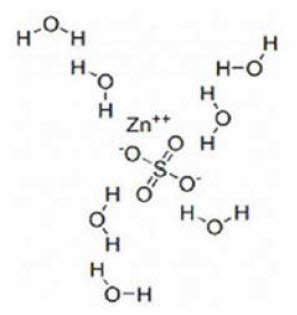
Molecular formula: ZnSO4 7H2O.
Molecular weight: 287.54 g/mol.Cupric sulfate exists as a pentahydrate. The structural formula is:
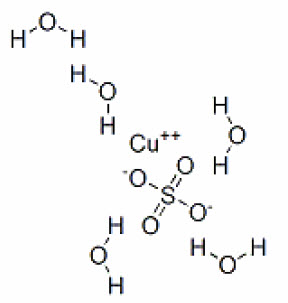
Molecular formula: CuSO4 5H2O.
Molecular weight: 249.69 g/mol.
Manganese sulfate exists as a monohydrate. The structural formula is: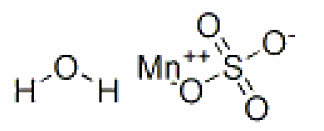
Molecular formula: MnSO4 H2O.
Molecular weight: 169.02 g/mol.
The structural formula of selenious acid is: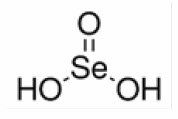
Molecular formula: H2SeO3.
Molecular weight: 128.97 g/mol.Multrys contains no more than 1,500 mcg/L of aluminum.
-
12 CLINICAL PHARMACOLOGY
12.1 Mechanism of Action
Zinc
Zinc functions as a cofactor of various enzymes including DNA polymerases, RNA polymerases, alcohol dehydrogenase, and alkaline phosphatases. Zinc is a coordinator of protein structural folding that interacts with a variety of proteins, lipids, and nucleic acids. In addition, zinc is a catalyst of essential biochemical reactions, including activation of substrates of carbonic anhydrase in erythrocyte.
Copper
Copper is a cofactor for many metalloenzymes acting as an oxidase to achieve reduction of molecular oxygen. Examples of copper metalloenzymes include but are not limited to lysyl oxidase, monoamine oxidase, ferroxidase, cytochrome C oxidase, dopamine beta monooxygenase, tyrosinase, and superoxide dismutase.
Manganese
Manganese is essential for the normal catalytic activity of several metalloenzymes including manganese superoxide dismutase, arginase, glutamine synthetase, phosphoenolpyruvate decarboxylase, and pyruvate carboxylase. Manganese contributes to the normal function of several other enzyme families including the oxidoreductases, transferases, hydrolases, lyases, isomerases, and ligases.
Selenium
Selenious acid is converted in vivo to hydrogen selenide via glutathione-involved electron reductions. Hydrogen selenide acts as a selenium pool to form selenoproteins which include, but are not limited to, glutathione peroxidase, iodothyronine deiodinase, peroxidase, and thioredoxins.
12.2 Pharmacodynamics
The exposure-response relationship and the time course of pharmacodynamic response are unknown for zinc, copper, manganese, and selenium.
12.3 Pharmacokinetics
Zinc
Over 85% of total body zinc is found in skeletal muscle and bone. In blood, zinc is mainly localized within erythrocytes. Approximately 80% of serum zinc is bound to albumin and the remainder to α-2-macroglobulin and amino acids. In adults, zinc is primarily excreted via the gastrointestinal tract and eliminated in the feces. A smaller amount of zinc is excreted via the kidneys in the urine. Urinary zinc excretion rates in very low birth weight preterm infants are relatively high in the neonatal period, and they decline to a level on a body weight basis that is similar to that of normal adults by two months of age.
Copper
In plasma, about 7% of copper is bound to albumin and amino acids. In the liver, about 93% of copper is bound to ceruloplasmin and released to the serum. Copper is excreted in bile and into the gastrointestinal tract where it is not reabsorbed. Copper is also eliminated through the kidneys.
Manganese
Manganese is widely distributed in body tissues including liver and specific brain regions such as the basal ganglia. The concentrations of manganese are higher in erythrocytes compared to the plasma or serum concentrations. In human plasma, manganese is bound to albumin and β1-globulin. Manganese is found in human bile suggesting biliary excretion.
Selenium
In humans, 85% of intravenous administered 75Se-sodium selenite was protein-bound within 4 to 6 hours and 95% by 24 hours.
-
16 HOW SUPPLIED
Multrys (trace elements injection 4*, USP) is a clear, colorless to slightly blue solution supplied in:
- 1 mL single-dose vial (NDC: 0517-9302-01) and packaged in trays containing 25 vials per tray (NDC: 0517-9302-25).
*Each mL of Multrys contains zinc 1,000 mcg, copper 60 mcg, manganese 3 mcg, and selenium 6 mcg.
Vial closure is not made with natural rubber latex.
Store at 20°C to 25°C (68°F to 77°F), excursions permitted to 15°C to 30°C (59°F to 86°F) [See USP Controlled Room Temperature].
Store admixed solution at 2ºC to 8ºC (36ºF to 46ºF) [see Dosage and Administration (2.3)].
-
17 PATIENT COUNSELING INFORMATION
Inform patients, caregivers, and home healthcare providers of the following risks of Multrys:
- Pulmonary embolism due to pulmonary vascular precipitates [see Warnings and Precautions (5.1)]
- Vein damage and thrombosis [see Warnings and Precautions (5.2)]
- Neurologic toxicity with manganese [see Warnings and Precautions (5.3)]
- Hepatic accumulation of copper and manganese [see Warnings and Precautions (5.4)]
- Aluminum toxicity [see Warnings and Precautions (5.5)]
- Hypersensitivity reactions with zinc and copper [see Warnings and Precautions (5.7)]
- SPL UNCLASSIFIED SECTION
-
PRINCIPAL DISPLAY PANEL - Container Label
NDC 0517-9302-01
Rx Only
Multrys® (Trace Elements Injection 4*, USP)
*Each mL provides: zinc 1,000 mcg, copper 60 mcg, manganese 3 mcg, and selenium 6 mcg
For intravenous infusion after admixingFor use in neonatal and pediatric patients weighing less than 10 kg
1 mL Single-Dose Vial - Discard Unused Portion
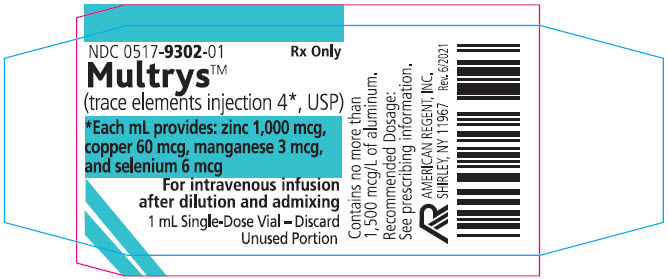
-
PRINCIPAL DISPLAY PANEL - Carton Labeling
NDC 0517-9302-25
Rx Only
Multrys® (Trace Elements Injection 4*, USP)
*Each mL provides: zinc 1,000 mcg, copper 60 mcg, manganese 3 mcg, and selenium 6 mcgFor intravenous infusion after admixing
For use in neonatal and pediatric patients weighing less than 10 kg
25 x 1 mL Single-Dose Vials - Discard Unused Portion
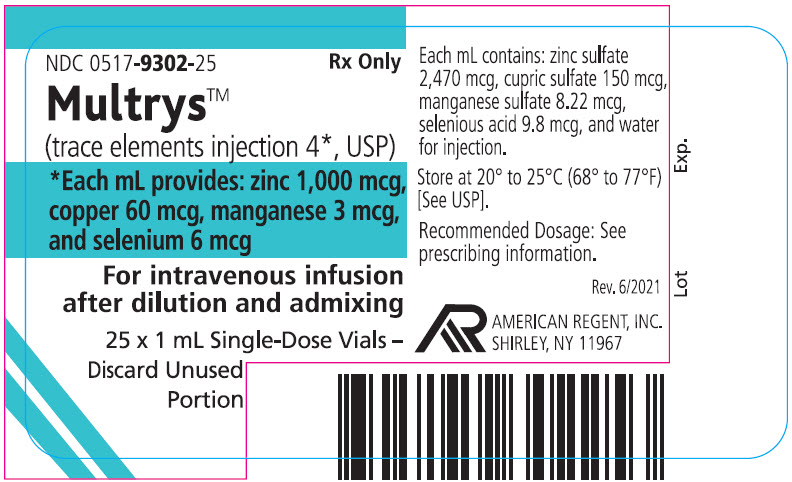
-
INGREDIENTS AND APPEARANCE
MULTRYS
trace elements injection 4 injection, solutionProduct Information Product Type HUMAN PRESCRIPTION DRUG Item Code (Source) NDC: 0517-9302 Route of Administration INTRAVENOUS Active Ingredient/Active Moiety Ingredient Name Basis of Strength Strength ZINC SULFATE (UNII: 89DS0H96TB) (ZINC CATION - UNII:13S1S8SF37) ZINC CATION 2470 ug in 1 mL CUPRIC SULFATE (UNII: LRX7AJ16DT) (CUPRIC CATION - UNII:8CBV67279L) CUPRIC CATION 150 ug in 1 mL MANGANESE SULFATE (UNII: W00LYS4T26) (MANGANOUS CATION - UNII:H6EP7W5457) MANGANOUS CATION 8.22 ug in 1 mL SELENIOUS ACID (UNII: F6A27P4Q4R) (SELENIOUS ACID - UNII:F6A27P4Q4R) SELENIOUS ACID 9.8 ug in 1 mL Inactive Ingredients Ingredient Name Strength WATER (UNII: 059QF0KO0R) Packaging # Item Code Package Description Marketing Start Date Marketing End Date 1 NDC: 0517-9302-25 25 in 1 TRAY 09/01/2021 1 NDC: 0517-9302-01 1 mL in 1 VIAL, SINGLE-DOSE; Type 0: Not a Combination Product Marketing Information Marketing Category Application Number or Monograph Citation Marketing Start Date Marketing End Date NDA NDA209376 09/01/2021 Labeler - American Regent, Inc. (002033710) Establishment Name Address ID/FEI Business Operations American Regent, Inc. 002033710 analysis(0517-9302) , manufacture(0517-9302)
Trademark Results [Multrys]
Mark Image Registration | Serial | Company Trademark Application Date |
|---|---|
 MULTRYS 90579713 not registered Live/Pending |
American Regent, Inc. 2021-03-15 |
 MULTRYS 88181166 not registered Live/Pending |
Luitpold Pharmaceuticals, Inc. 2018-11-05 |
© 2025 FDA.report
This site is not affiliated with or endorsed by the FDA.
